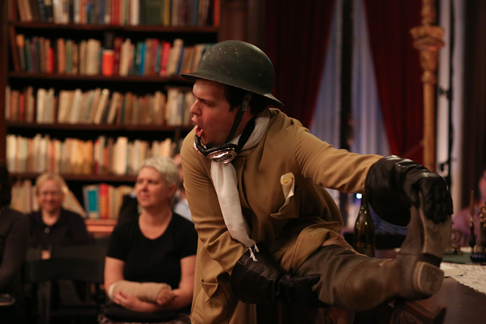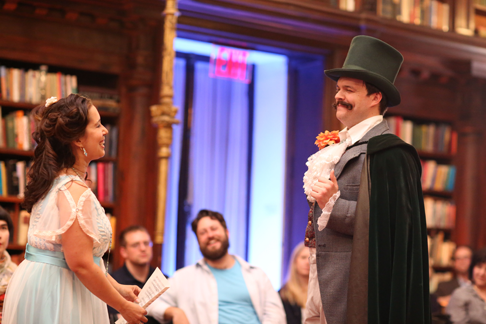15 Jun 2015
Giovanni Paisiello: Il Barbiere di Siviglia
Written in 1783, Giovanni Paisiello’s Il Barbiere di Siviglia reigned for three decades as one of Europe’s most popular operas, before being overshadowed forever by Rossini’s classic work.

Written in 1783, Giovanni Paisiello’s Il Barbiere di Siviglia reigned for three decades as one of Europe’s most popular operas, before being overshadowed forever by Rossini’s classic work.
Rossini was ruthless, rippling off swaths of both Paisiello’s libretto and his music. This infuriated diehard Paisiello fans, whose cries of anger famously caused the 1816 premiere of Rossini’s opera to flop. Yet they could not keep a good work down for long. Rossini trumps his predecessor at every turn: his music has greater vitality, originality and wit, and his dramatic conception imbues the stock characters of Italian commedia dell’arte with a universal humanity that we still recognize today.
This famous history poses a psychological problem for any listener at a rare revival of Paisiello’s opera: how can one avoid keeping score? One is constantly tempted to engage in number-by-number comparison with the more famous version, which distracts from the virtues of the earlier one. After all, Paisiello’s Barbiere was famous for a reason: it is a minor masterpiece on its own terms, with simplicity of musical expression, directness of utterance and suave 18th century gentility all its own.
 David Blalock as Count Almaviva
David Blalock as Count Almaviva
A recent production at On Site Opera in New York achieved the seemingly impossible. The performance I attended on June 11th was so fresh, original and immediate that, within minutes, it banished any thought of Rossini from my mind.
Much of the success was due to the magic of in situ performance, which is the calling card of this company: its productions are set in appropriate “everyday” spaces throughout New York, where singers perform just a few feet from a small audience. This Barbiere was presented in and around the lovely Fabbri Mansion on East 95th Street, built in Italian Renaissance style. For the first scene, an audience of just 80 was seated in a small front courtyard. Figaro and Almaviva entered through a front ironwork gate, Bartolo peered out of the front door of the mansion, and Rosina sang from a second-story window. We then moved upstairs to a balconied Italianate library room that might have been in Pesaro, Parma or Seville. Throughout, there were no sets and few props, just this appropriate setting. All this seemed just right for an opera written for audiences of a few hundred gathered in small theaters, often in mansions or palaces. Though the combination of intimate surroundings, superb diction and fine acting all but dispensed with any need for supertitles, they were provided on modest HD screens.
 Monica Yunus as Rosina and David Blalock as Count Almaviva
Monica Yunus as Rosina and David Blalock as Count Almaviva
To revive a second-tier opera in an intimate setting, a company needs singing actors who are completely secure technically and credible, musically and dramatically, even with spectators just three feet away. Credit for the brilliant success of this production is thus due, above all, to the cast. Despite oppressive 90+ degree heat, they rendered this opera as fresh and immediate as it must have appeared to listeners in Paisiello’s heyday. The performers, mostly in their 30s with solid national and international successes, seemed to revel in the challenge, responding with completely credible singing and acting.
Andrew Wilkowske’s warm and full-voiced baritone was well-suited to his charismatic and characterful portrayal of Figaro. His voice sounds like it has the potential to evolve into the rarest of all things in modern opera: a great Verdi baritone. Soprano Monica Yunus made a winning Rosina. She succeeded almost entirely in warming up an essentially lyric coloratura voice to fit this more lyric role—musically and dramatically, Paisiello’s Rosina is more pensive and less forward than Rossini’s—aided by exceptionally lovely breath control and phrasing. As Almaviva, tenor David Blalock looked the part and sang competently, though he struggled at times to generate an appropriately light and warmly elegant tone, for example in Lindoro’s serenade (in the 18th century, the opera’s most famous number). Bass Rod Nelman blustered his way through Bartolo’s travails with a focused, brilliant tone, while bass-baritone Isaiah Musik-Ayala acted and sang well in the part of his buddy Basilio, paying scrupulous attention to Paisiello’s dynamics in the big aria, which are subtler than those of Rossini. Baritone Benjamin Bloomfield and Jessica Rose Futran rendered the servant’s slapstick credible, with the former deploying an extraordinarily large voice and the latter a voice noticeably smaller than those around her.
The orchestra was a slimmed down to eight and played under the inspired direction of Geoffrey McDonald. A few intonation issues aside, inevitable at that scale and with different environments, the players were skilled and energetic. The musical preparation was superb. At no moment did the flow of the music threaten to fray, despite the extraordinary challenges of conducting a group of singers often facing away from the conductor.
Overall I enjoyed this evening as much as any live opera I’ve attended in the last decade. The performance captured the spirit of the work. I was surely not alone: I looked around the room as we exited and everyone was smiling. More than that, this performance spoke to the state of opera as an art form. As larger companies like the Met, just across the park, continues to struggle with resources and relevance, smaller companies like On Site Opera are experimenting with performance in non-traditional spaces, generally at something closer to the scale at which these many works were historically meant to be heard. Perhaps they are have found a viable route back to the future.
Andrew Moravcsik